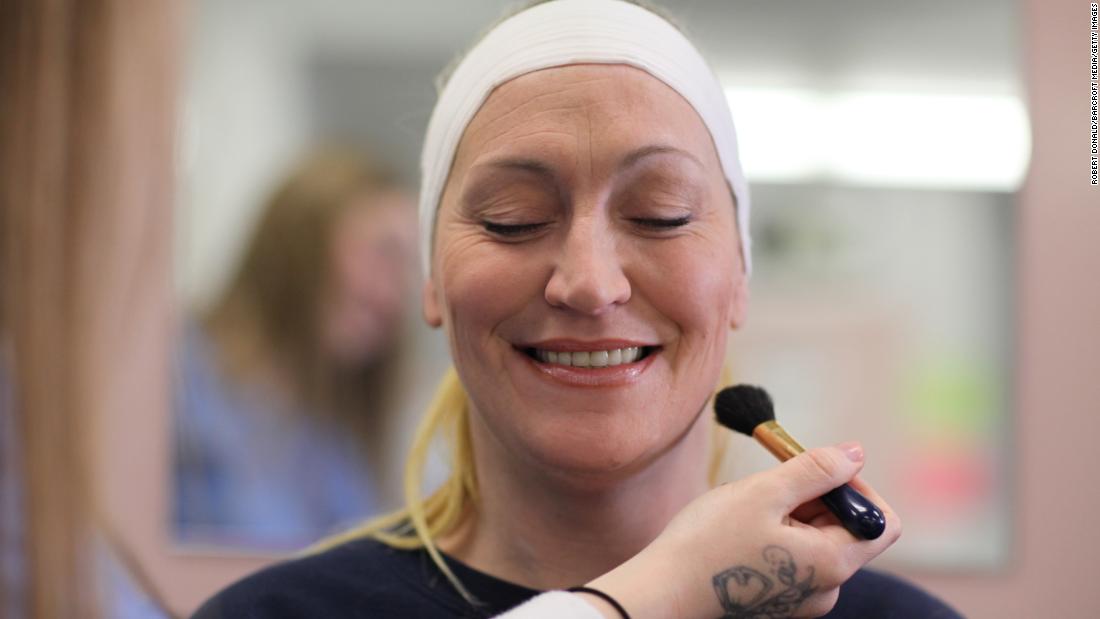Beauty behind bars: Why makeup matters for prisoners

“It makes me feel good, like a real human being — not just a number,” she said over email. “The cheap stuff they sell makes me break out, but it’s all we have (so I use it).”
Seven hundred miles south, Susan Ferguson, an inmate inside the Central California Women’s Facility, in Chowchilla, has an equally consistent beauty routine. “Getting my hair and nails taken care of is self-care,” she said via a letter. “Everyone is sick… it makes me feel normal.” But pandemic-related supply chain problems have created cosmetic shortages at prison commissaries.
Many inmates find comfort in cosmetics. Stripped of freedom, friends and family, makeup can help inmate retains a sense of identity and present themselves in the manner they choose, rather than as dictated by strict prison dress codes.

A cosmetology class in progress at Metro State Prison in Atlanta, where inmates practice hairdressing. Credit: Ric Feld/AP
In 1998, Virginia’s department of corrections attempted to ban makeup, citing its contraband potential. Patricia L. Huffman, warden of Fluvanna Correctional Center protested the ban. “We’re providing an opportunity for women to become better at dealing with the world … a piece of that is how we look,” she told the Washington Post at the time. The cosmetic clampdown was rolled back.
“Not giving people the opportunity to attend to their appearance is just another way of dehumanizing and making people feel as if they’re worthless,” said Vollen-Katz, who views restrictive cosmetic rules as another example of prisons overstepping their bounds. “We’ve moved away from rehabilitation and become far more about retribution. Controlling women has long been at the forefront in the prison system.”
Necessary innovation
Over the decades, frustrated prisoners have taken creative approaches to acquire cosmetics.
In the 1920s, women inside England’s Holloway Prison scraped paint chips off their cell walls to use as face powder and dampened red paper to use as rouge. In 1929, women inmates in New Jersey surreptitiously used pages torn from prison library books to twist and curl their hair and “pencil(ed) their eyebrows with pieces of wood reduced to charcoal,” according to a local newspaper report. In the 1950s, wax paper became a hot ticket item when it was discovered that it could be melted down and used to straighten hair or give it shine.

An inmate in Brazil double-checks her beauty look before competing in a beauty pageant at the Talavera Bruce Women’s Prison in 2015. Credit: Mario Tama/Getty Images
The dining hall provided other resources. Women pocketed sticks of butter and mixed them with pencil shavings to create homemade mascara and eye shadow. In the 1960s, women used lightbulb shards to trim their hair into prohibited bobs (so-called masculine haircuts were forbidden).
In 1945, Lord Thomas Caldecote appealed the UK’s ban on beauty products at the annual meeting of the Police Courts and Prison Gate Mission, a charity that helped reintegrate ex-convicts into society. “Women are so lost without cosmetics that even in prison they feel a little more disreputable when cosmetics are lacking,” he reportedly argued at a police meeting. He managed to convince his peers and an experimental trial was instigated: each inmate allotted one lipstick, one box of powder and a jar of cold cream.

A view of a former political prisoner in Bangkok cutting off donated lipstick tubes to be melted down and recycled for female inmates. Credit: Lillian Suwanrumpha/AFP/Getty Images
As prisons reworked their rules, approval to purchase and wear cosmetics often went hand in hand with arbitrary constraints. In the 1940s, women at the federal reformatory in Seagoville, Texas, were permitted blush, lipstick and clear nail polish — with an emphasis on clear. “Attempt(s) to circumvent this ruling by mixing lipstick with clear polish… didn’t work very well,” reported the Fort Worth Star-Telegram.
In the 1950s, Canadian inmates were allowed powder and lipstick but not eyeliner or mascara, an approach also taken by New York’s Westfield State Farm Prison and Reformatory. “The girls were going overboard — we want them to look like ladies,” Westfield’s superintendent, Genevieve Meyer said to the Democrat and Chronicle newspaper.
Cosmetology classes
Kross’ early reforms included a makeover of the Women’s House of Detention, a bleak fortress-like building in Greenwich Village. The cells were refurbished and the bars painted pastel pink. Her philosophy: An improved environment lays the groundwork for change.

Prisoners getting their hair cut by fellow inmates, who are learning to be hairdressers at HM Prison Styal, England. Credit: Andrew Aitchison/Corbis/Getty Images
The beauty program opened inside the Women’s House of Detention in 1956, outfitted with curling irons, dryers and electric stoves where Black inmates learned to press, wash and wax their hair. They also received free periodic “moral building” treatments, and an additional treatment before court hearings. This was the first time in the New York City Department of Correction’s history that funds were allotted to women’s education courses (typing, sewing and culinary arts followed). The beauty salon was heavily oversubscribed; its 1965 tally included 2,420 manicures, 1,239 haircuts, 8,627 tweezed eyebrows, 4,427 bleaches, 891 dyes, 4,055 shampoos and 9,082 presses.

An inmate has her hair washed as she prepares to compete in the 13th annual Miss Talavera Bruce beauty pageant at the penitentiary the pageant is named for, in Rio de Janeiro, Brazil in 2018. Credit: Silvia Izquierdo/AP
This petty destruction of dignity illustrates the power the prison industry exerts over women’s bodies, explained Vollen-Katz. “Appearance factors into how women see themselves and think about themselves,” she said. “Cosmetics are not a basic health need, but in a system that strips people of identity, policies that tear people down is a mistake.”
While the right to rouge may seem insignificant when compared with other prisoners’ campaigning issues, it is indicative of how the system often fails to meet women’s physical and psychological needs.
“It’s really important to present yourself as put together,” she said. “But I’ve learned to be flexible.”



